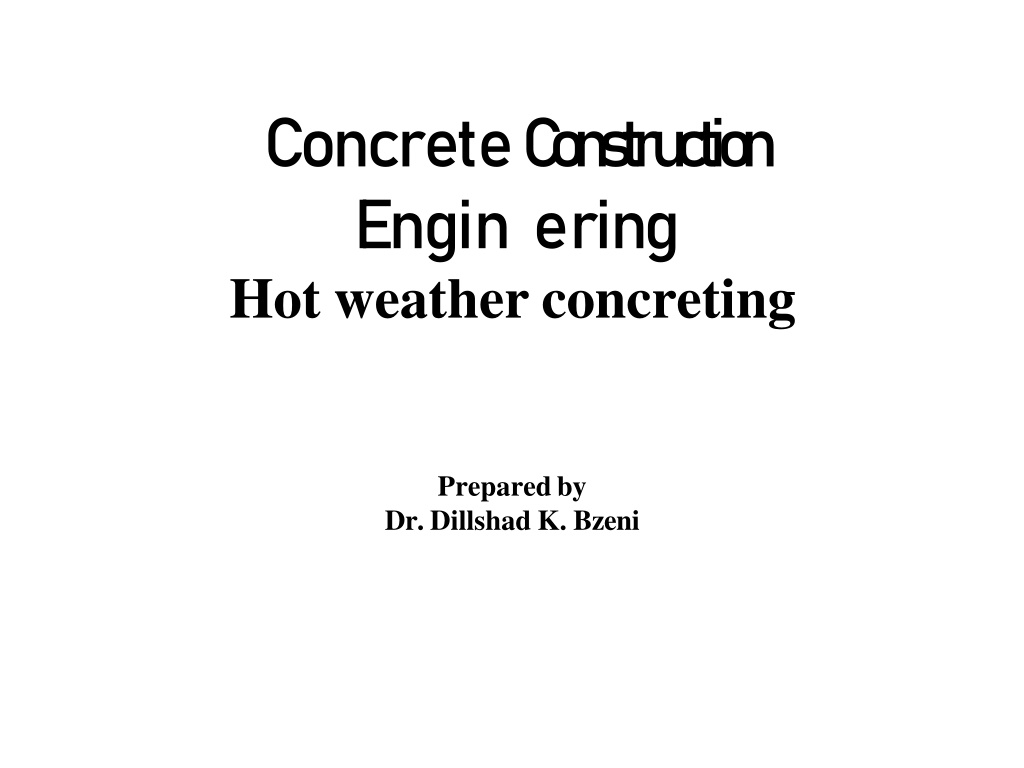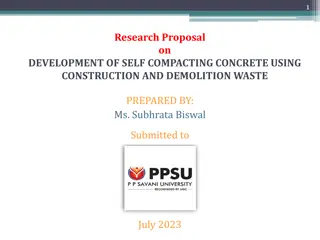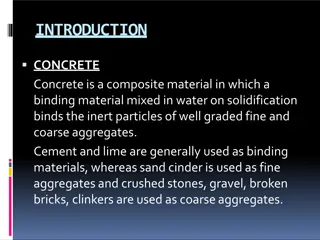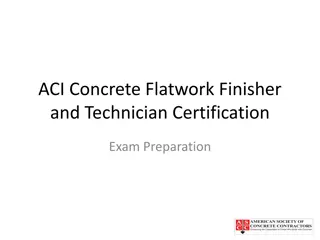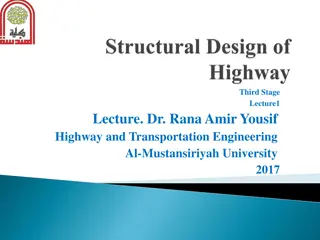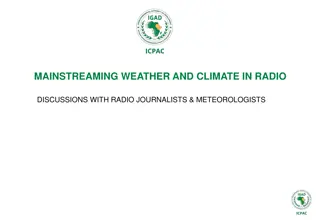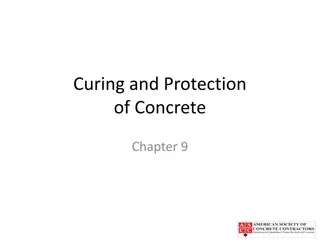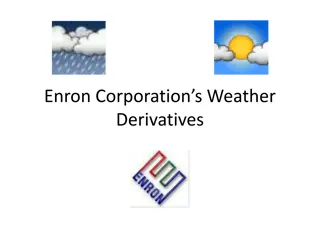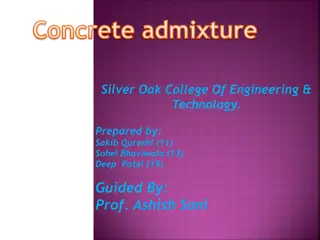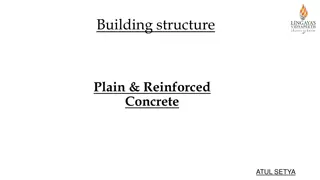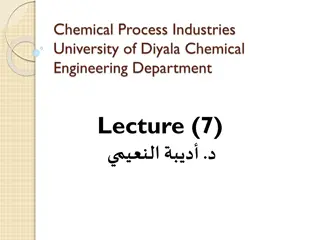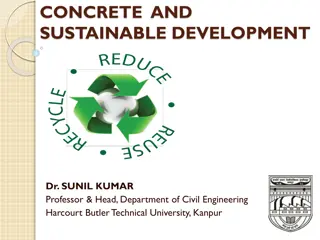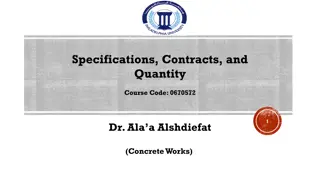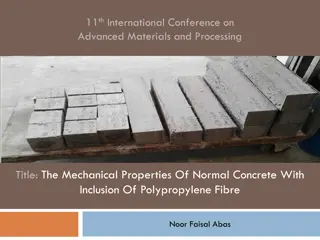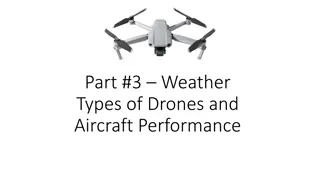Hot Weather Concreting: Potential Problems and Effects on Concrete Properties
Hot weather conditions can significantly impact the quality of concrete, leading to problems such as increased water demand, slump loss, setting issues, and durability concerns. These conditions can result in reduced strength, plastic shrinkage cracking, and other detrimental effects on both fresh and hardened concrete. Understanding the challenges posed by hot weather concreting is crucial for maintaining the integrity of concrete structures.
Download Presentation

Please find below an Image/Link to download the presentation.
The content on the website is provided AS IS for your information and personal use only. It may not be sold, licensed, or shared on other websites without obtaining consent from the author. Download presentation by click this link. If you encounter any issues during the download, it is possible that the publisher has removed the file from their server.
E N D
Presentation Transcript
ConcreteC onstruction Enginering Hotweatherconcreting Preparedby Dr.DillshadK.Bzeni
Definition Hotweatherisanycombinationofthefollowing conditionsthattendstoimpairthequalityoffreshly mixedorhardenedconcretebyacceleratingtherate ofmoisturelossandrateofcementhydration,or otherwisecausingdetrimentalresults: Highambienttemperature; Highconcretetemperature; Lowrelativehumidity; Windspeed;and Solarradiation.
Potentialproblemsinhotweather -ForFreshConcrete Increasewaterdemand. Increaserateofslumplossandcorrespondingtendencytoaddwateratthejobsite; Increasedrateofsetting,resultingingreaterdifficultywithhandling,compacting, andfinishing,andagreaterriskofcoldjoints. Increasedtendencyforplastic-shrinkagecracking. -ForHardenedConcrete Decrease28-dayandlaterstrengthseitherbecauseofhigherwaterdemandor higherconcretetemperature. Increasetendencyfordryingshrinkagebecauseofevaporationofwater. Increasedifferentialthermalcrackingfromeithercoolingofthestructureor temperaturedifferentialwithinthecrosssectionofthemember Decreasedurabilityresultingfromcracking. Greatervariabilityofsurfaceappearance,suchascoldjointsorcolordifference,due todifferentratesofhydrationordifferentwater-cementitiousmaterialratios(w/cm). Increasedpotentialforreinforcingsteelcorrosion. Increasedpermeabilityasaresultofhighwatercontentandinadequatecuring
EffectofHotweatheronconcreteProperties EffectonStrength Concretemixed,placed,andcuredatelevatedtemperaturesnormallydevelops higherearlystrengthsthanconcreteproducedandcuredatlowertemperatures, butstrengthsaregenerallylowerat28daysandlaterages. researchersconcludethatarelativelymoreuniform micro-structureofthehydratedcementpastecan explainforhigherstrengthofconcretemixturescast andcuredatlowertemperatures. Specimensmoldedandcuredinairat23oC,60% relativehumidityandat38oC,25%relativehumidity producedstrengthsofonly73and62%,respectively,of thatobtainedforstandardspecimensmoist-curedat23o Cfor28days. Thelongerthedelaybetweencastingthecylindersand placingintostandardmoiststorage,thegreaterthe strengthreduction. Thedataillustratethatinadequatecuringin combinationwithhighplacementtemperaturesimpairs thehydrationProcessandreducesstrength.
Plasticshrinkagecracking The reduction in volume of fresh concrete is known as plastic shrinkage. With slabs, rapid drying of fresh concrete causes plastic shrinkage when the rate of loss of water from the surface exceeds the rate at which the bleed water is appearing. At the same time, cracks will develop if the concrete near the surface has become too stiff to move but is not strong enough yet to withstand the tensile stress caused by the restrained shrinkage. Typical plastic shrinkage cracks are parallel to one another and are 0.3 to 1 m apart and 25 to 50 mm deep. Thesecrackscouldbefurther widenedovertimeduetoconventionaldryingshrinkageand/ortemperature changes. Theriskofplasticshrinkagecrackingcouldbeestimatedbasedonthefollowing values PlasticPeriod[hours] EvaporationRate[kg/m2/h] BleedingVolume[kg/m2] PlasticPeriod:ThePlasticPeriodofconcreteis definedastheperiodafterthecompactionof theconcretetotheinitialsettingtime(pointof stiffening)oftheconcrete.
Howtominimizeplasticshrinkagecrack 1. Erecttemporarywindbreakstoreducethewindvelocity 2. Inveryhotanddryperiodusefogspraytoreducetherateofevaporation 3. Covertheconcretewithmoistureretainingcoveringsuchaswetburlap 4. Startcuringassoonaspossible,useliquidmembranecuringcompounds 5. Usesyntheticfiberswithconcrete 6. Acceleratethesettingtimeofconcreteandavoidlargetemperaturedifference betweenconcreteandairtemperature 7. Refinishorrecompacttheconcretewhentheconcretestifftoresisttheapplied loadandbeforefinalsetting PlasticShrinkageCrackingRisk Theprobabilityforplastic-shrinkagecrackstooccurmaybeincreasedifthe settingtimeoftheconcreteisdelayedduetotheuseof slow-settingcement, anexcessivedosageofretardingadmixture, flyashasacementreplacement, cooledconcrete. Flyashisalsolikelytoreducebleedingandmaytherebycontributetoa crackingtendency
Rateofevaporation Definedastherateatwhichsurfacewaterwouldevaporatefromtheconcrete duringthePlasticPeriod Table-1Typicalvaluesofevaporationrate TheEvaporationRatecanbecalculatedbyeitherusingthefollowingequationor usingthenomograph withERtheevaporationrate,Tctheconcretetemperature,Tatheambient temperature,RHtherelativehumidityin%andVthewindspeedinkm/h.
EstimatingrateofevaporationusingNomograph ThenomographinFig.2isbasedoncommonhydrologicalmethodsforestimatingthe rateofevaporationofwaterfromlakesandreservoirs,andisthereforetheMost accuratewhenestimatingtherateofevaporationfromthesurfaceofconcretewhile thatsurfaceiscoveredwithbleedwater. Whenevaporationrateisexpectedtoapproachthebleedingrateoftheconcrete, precautionsshouldbetaken.bleedingratesvaryfromzerotoover(1.0kg/m2/h),over time,andarenotnormallymeasured,itiscommontoassumeavalueforthecritical rateofevaporation.Themostcommonlyquotedvalueis(1.0kg/m2/h). Inotherplaces,criticalevaporationrateinconstructionspecified0.75kg/m2/h,or0.5 kg/m2/h.
Fig.2 Nomograph-ACI305 (a) Windspeedmustbe measuredat0.5mabove theevaporatingsurface. Verylargeerrorsresult fromusingoffsitewind data. (b) Airtemperaturemustbe measured1.2 1.8mabove theevaporatingsurface andintheshade. (c) Humiditylikewisemustbe measured1.2 1.8mabove theevaporatingsurface. (d) Concretesurface temperatureshouldbe usedforthetemperature oftheevaporatingwater.
Effectofconcretetemperature Theamountofthewaterrequiredtoproduce agivenslumpincreaseswiththetime.For constantmixingtime,theamountofwater requiredtoproduceagivenslumpalso increaseswiththetemperature,asshownin figure-3. Increasedwatercontentwillcreateadecrease instrengthanddurability. Insectionsoflargedimensions,therewillbe anincreasedrateofhydrationandheat evolutionthatwillincreasedifferencesin temperaturebetweentheinteriorandthe exteriorconcrete.Thismaycausethermal cracking Figure-3Effectofconcretetemperatureon slumpandonwaterrequiredtochange slump
Usingiceaspartofthemixingwaterhas remainedamajormeansofreducing concretetemperature.Onmelting,ice absorbsheatattherateof335J/g.Tobe mosteffective,theiceshouldbe crushed,shaved,orchippedwhenplaced directlyintothemixeraspartofthe mixingwater.Formaximum effectiveness,theiceshouldnotbe allowedtomeltbeforeitisplacedinthe mixerincontactwithotheringredients, however,butitmustmeltcompletely priortothecompletionofmixingofthe concrete. Figure-4Generaleffectsoficeinmixingwateron concretetemperature.Temperaturesarenormal mixingwatertemper
Effectofcement HighconcretetemperatureincreasestherateofhydrationAsaresult,concrete stiffensmorerapidlyandrequiresmorewatertoproduceormaintainthe Desiredslump. usingslowerhydratingcements,theslowerrateofheatdevelopmentandthe simultaneousdissipationofheatfromtheconcreteresultinlowerpeak temperatures.Therewillbelessthermalexpansion,andtheriskofthermal crackinguponcoolingoftheconcretewillbereduced. Supplementarycementitiousmaterials Theuseofflyash: 1. reducetherateofslumplossofconcreteunderhotweatherconditions 2. theymayimpartaslowerrateofsettingtheconcrete,whichisdesirableinhot weatherconcreting. Chemicaladmixtures Thebenefitsmayinclude: lowermixingwaterdemand, Extendedperiodsofuseandstrengthscomparableto,orHigherthan,concrete withoutadmixturesplacedatlowertemperatures.
ESTIMATINGCONCRETETEMPERATURE EquationsforestimatingtemperatureToffreshlymixedconcreteareshown inthefollowingequations where Ta=temperatureofaggregate Tc=temperatureofcement Tw=temperatureofbatchedmixingwaterfrom normalsupplyexcludingice Ti=temperatureofice.(Note:Thetemperatureof freeandabsorbedwaterontheaggregateis assumedtobethesametemperatureasthe aggregate.Alltem-peraturesareinForC.) Wa=drymassofaggregate Wc=massofcement Wi=massofice Ww=massofbatchedmixingwater Wwa=massoffreeandabsorbedmoisturein aggregateatTa.(Note:Allmassesareinlborkg.) Without-Ice With-Ice
PlasticSettlement ThecracksduetoPlasticSettlementarecommonlymisunderstoodtobedueto shrinkage.PlasticSettlementcracksoccurwhenthereisarelativelyhighamountof bleedingandsomeformofobstruction(e.g.reinforcement bars,tieboltsofformwork,largeaggregateparticlesetc.,)tothedownward settlementofthesolids. Theseobstructionsbreakthebackofconcreteandgeneratevoidsundertheirbelly, Asaresultcracksareformeddirectlyoverformworktieboltsoroverthe reinforcementneartopofasectionduetothearchingofconcreteovertheobstacle causingtensioninconcrete.Thesecracksaretypicallyfoundalongthelineof reinforcementoroverobstacles.Theamountofsettlementtendstobe proportionaltothedepthofconcrete,i.e.,thedeeperthesection,thegreaterthe settlement.Atlinesofchangesofsection,e.g.,atabeam/slab junction,thedifferentialamountofsettlementcanleadtocracksformingatthe surface.
